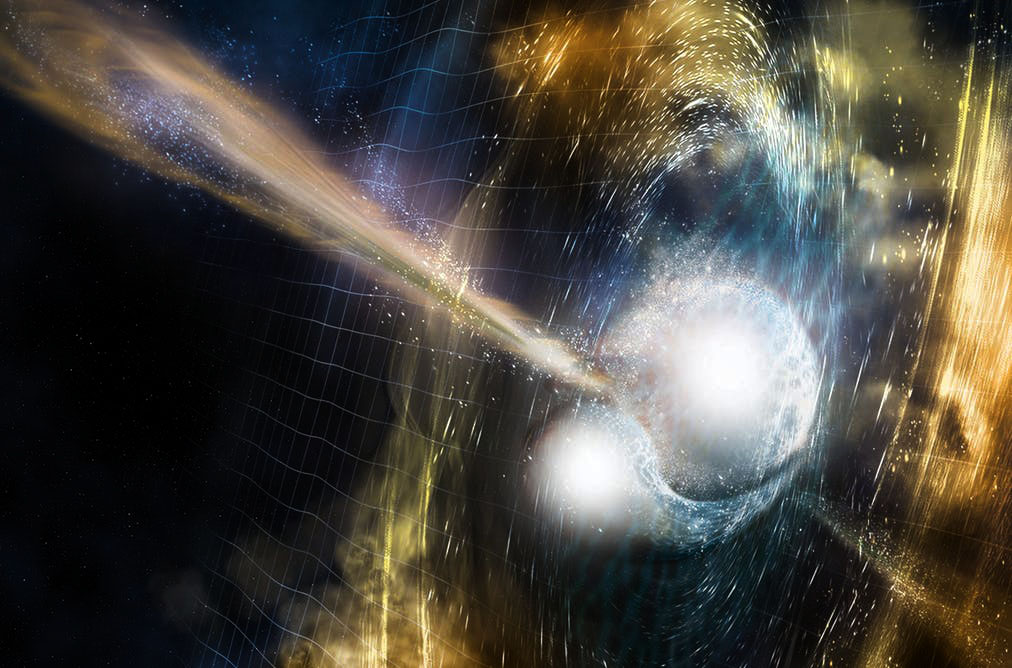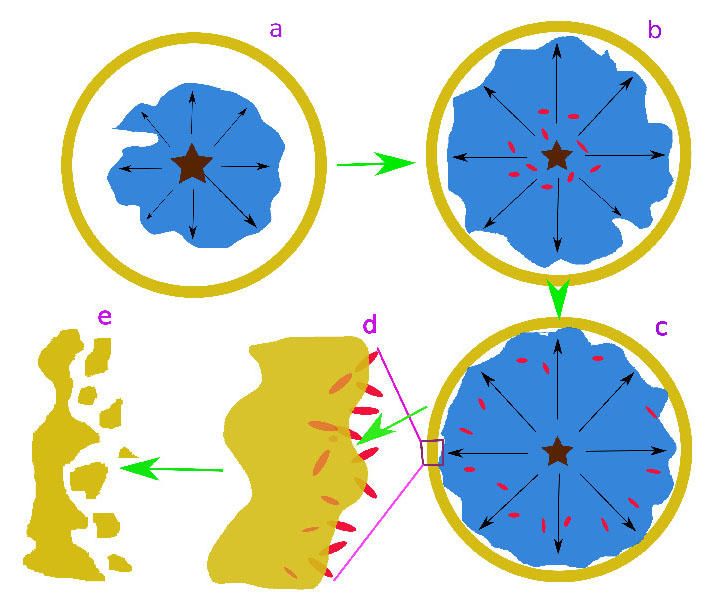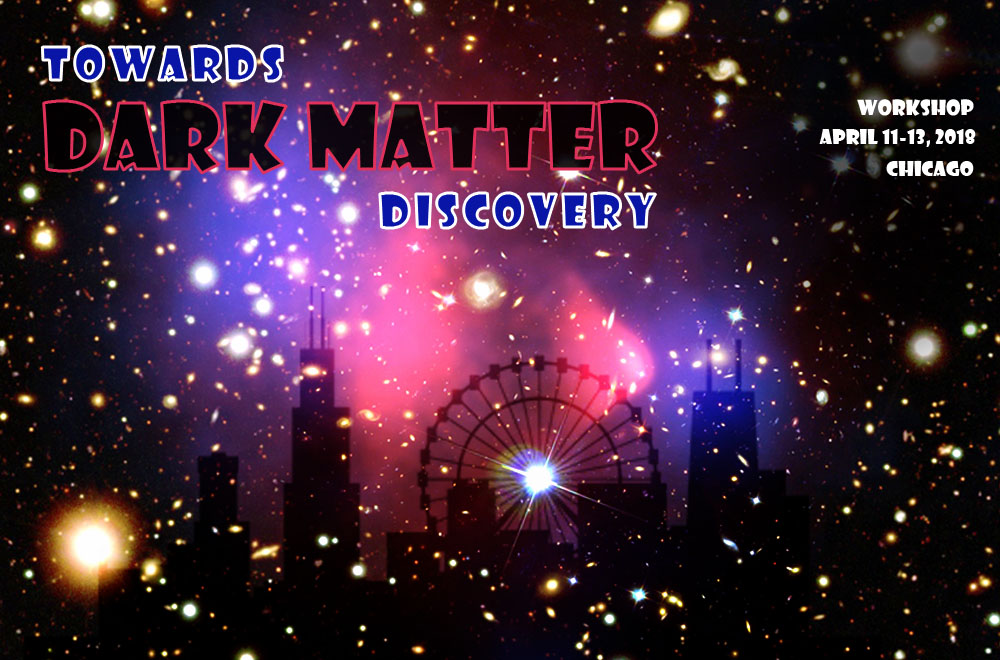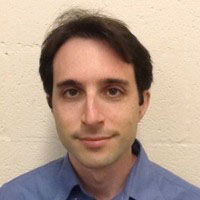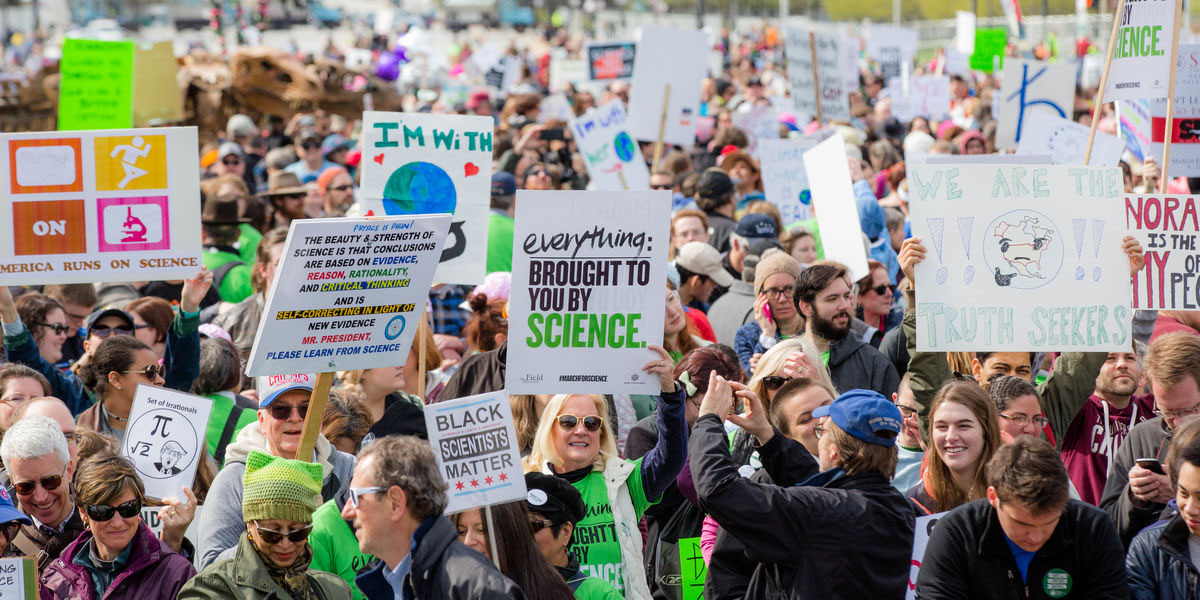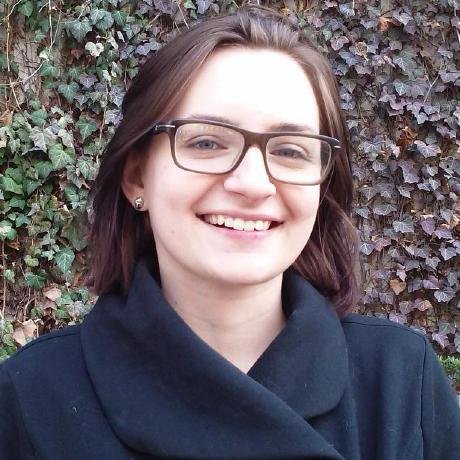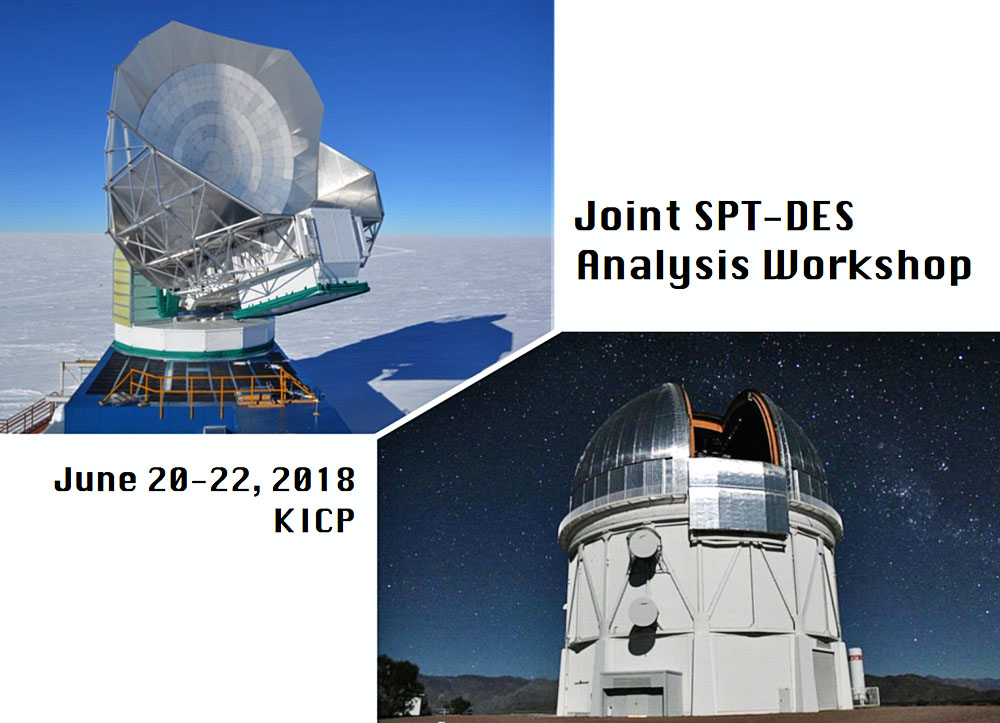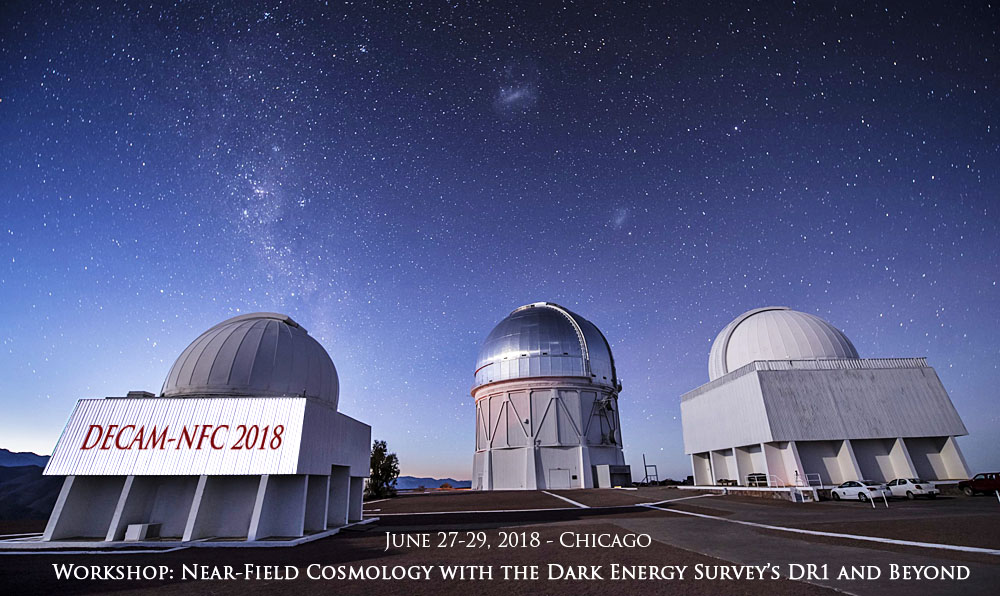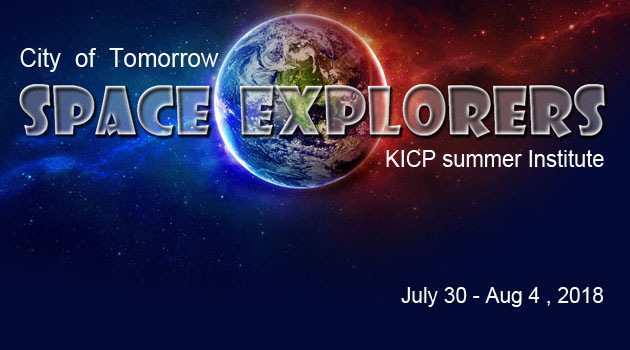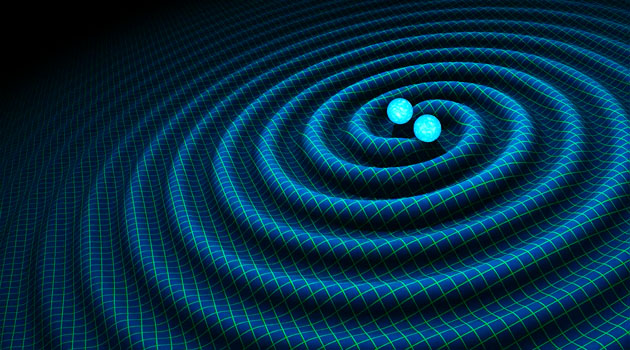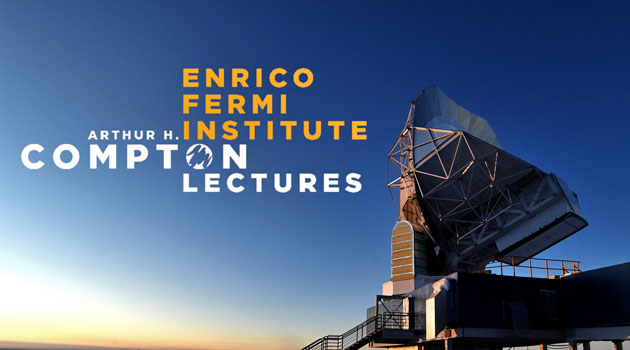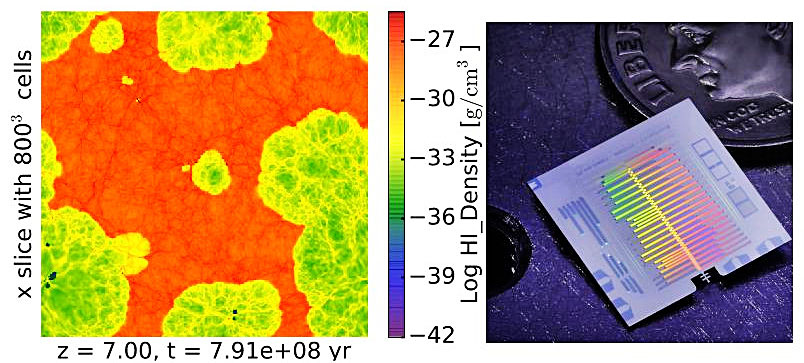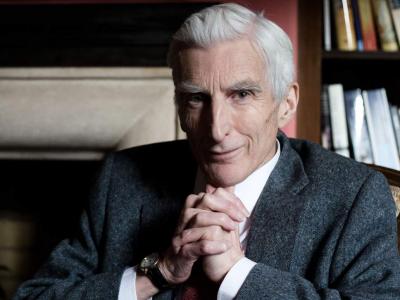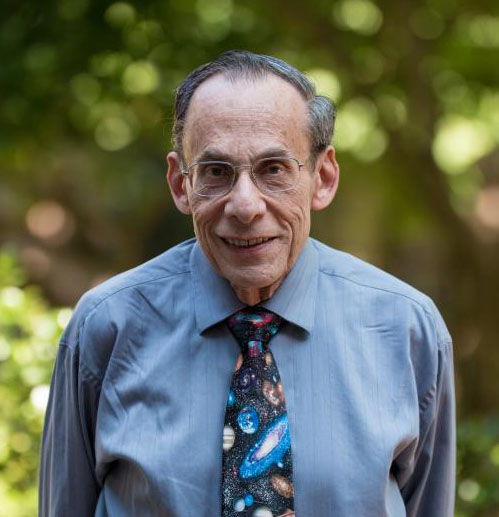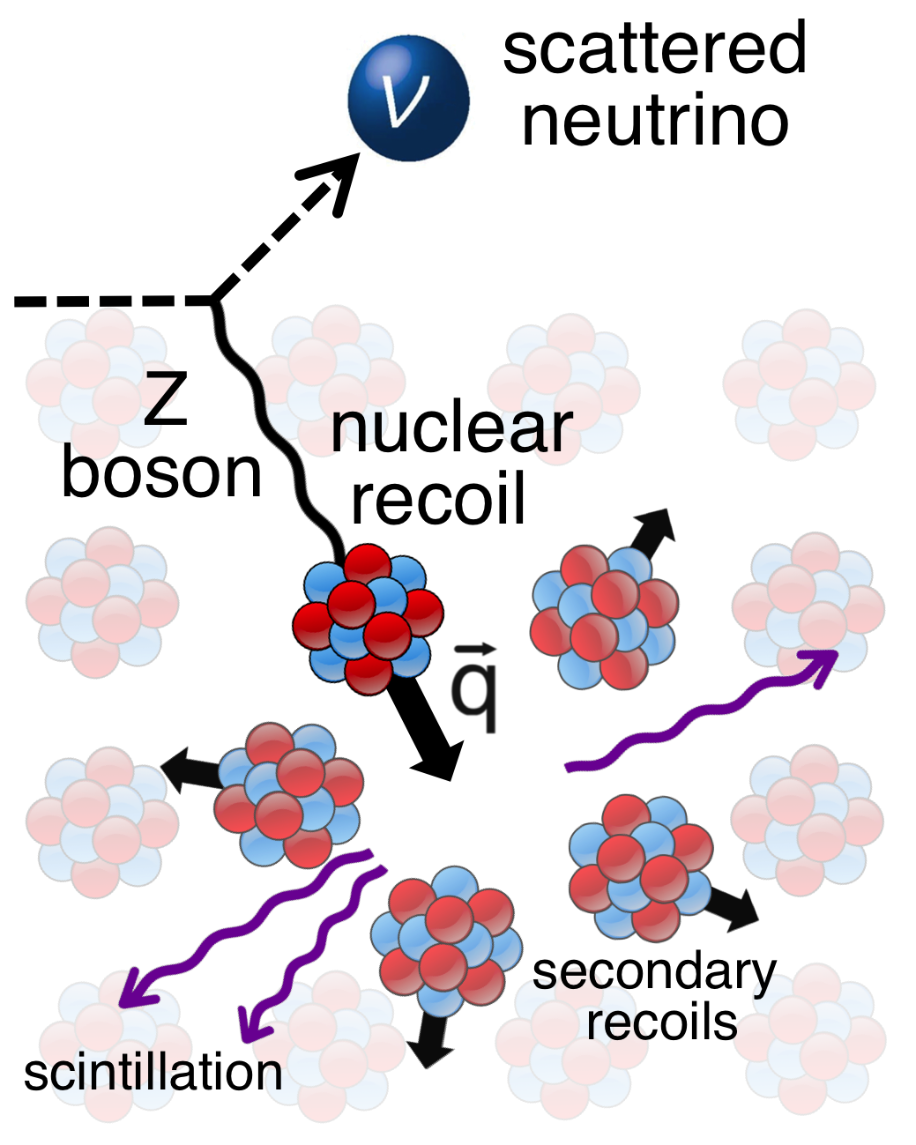 |
 |
 |
 |
 |
 |
 |
 |
 |
 |
 |
 |
|
Talks & Events
|
Workshops & Events: 2018 Daniel Holz, UChicago, "GW170817: Hearing and Seeing a Binary Neutron Star Merger" With the discovery of GW170817 in gravitational waves, and the discovery of an associated short gamma-ray burst, and the discovery of an associated optical afterglow, we have finally entered the era of gravitational-wave multi-messenger astronomy. I will discuss LIGO/Vigo's detection of this binary coalescence, and explore some of the scientific implications, including confirmation of the kilonova model and implications for the origin of gold and platinum in the universe, tests of general relativity, and the first standard siren measurement of the Hubble constant. GW170817 represents a momentous development in gravitational-wave astronomy, and the birth of gravitational-wave cosmology. Winter 2018 Postdocs Symposium
GeoSci Seminar: Vikram Dwarkadas, "Investigating a Stellar Wind Origin for High 26Al and Low 60Fe in the Early Solar System" A critical constraint on solar system formation is the high 26Al/27Al abundance ratio of 5e-5 at the time of formation, which was about 17 times higher than the average Galactic ratio, while the 60Fe/56Fe value was about 2e-8, lower than the Galactic value of 3e-7. This challenges the assumption that a nearby supernova was responsible for the injection of these short-lived radionuclides into the early solar system. We show that this conundrum can be resolved if the Solar System was formed by triggered star formation at the edge of a Wolf-Rayet (W-R) bubble. Aluminium-26 is produced during the evolution of the massive star, released in the wind during the W-R phase, and condenses into dust grains that are seen around W-R stars. The dust grains survive passage through the reverse shock and the low density shocked wind, reach the dense shell swept-up by the bubble, detach from the decelerated wind and are injected into the shell. Some portions of this shell subsequently collapses to form the dense cores that give rise to solar-type systems. The subsequent aspherical supernova does not inject appreciable amounts of 60Fe into the proto-solar-system, thus accounting for the observed low abundance of 60Fe. We discuss the details of various processes within the model using numerical simulations, as well as nucleosynthesis modelling, and analytic and semi-analytic calculations. We conclude that it is a viable model that can explain the initial abundances of 26Al and 60Fe. Astronomy & Astrophysics Open House
EFI seminar: Nahee Park, University of Wisconsin, "Probing high energy particle dynamics in our Galaxy with multimessenger observations" Cosmic rays, high energy particles originating from outside of the solar system, are believed to be dominated by particles from our Galaxy at least up to the energy of 10^15 eV. Since their discovery in 1912, the origin, acceleration, and propagation of these high energy particles have remained as open questions. In the last few years, new results from space-borne experiments, such as the rise of the positron flux and hardening of the light nuclei, have begun to challenge our understanding of these particles. Complementing this, indirect observations of the cosmic rays via very high energy gamma rays have started to shed light on the various particle accelerators in our Galaxy with discoveries of over a hundred Galactic sources. With the recent detection of astrophysical neutrinos by IceCube, the first unequivocal view of pure hadronic accelerators in our Universe became available. I will present what we have learned about the acceleration of high energy particles with gamma-ray observations based on the Galactic gamma-ray measurements from the VERITAS experiment, an imaging atmospheric Cherenkov telescope. I will show what we can learn from the future neutrino experiment IceCube Gen-2 and the future gamma-ray observatory CTA. Finally, I will highlight how these multimessenger observations come together to lead us toward a more coherent and complete picture of high energy particles in our Galaxy. Workshop: Towards Dark Matter Discovery Website The Kavli Institute of Cosmological Physics (KICP) at the University of Chicago is hosting the "Towards Dark Matter Discovery" workshop, which will be held from 11th to 13th April 2018 in the Eckhardt Research Center (ERC) on the University of Chicago campus. The workshop will explore new directions on the path toward discovering the nature of dark matter. The invited speakers are encouraged to share their expertise in the fields of primordial black holes, thermal relic dark matter, nonthermal relic dark matter, ultralight dark matter, superheavy dark matter, kinda-chubby dark matter, new strategies for direct detection, newer strategies for direct detection, avant-garde strategies for direct detection, and axions. During the three day workshop, we will host approximately 20 talks of 30 minutes each with generous time remaining for discussion. Visitors to the University of Chicago are invited to spend the entire week at the university. Broader Horizons: Matthew Lightman, data scientist lead at JPMorgan Chase in Chicago Organizer: Andrew Neil Please join us for our next Broader Horizons talk this Thursday, April 12 at 5 PM in ERC 576. Our speaker is Matthew Lightman, currently data scientist lead at JPMorgan Chase in Chicago. Matthew holds a Ph.D in physics from Columbia University, where his research focused on particle physics simulations. Broader Horizons is a talk series that explores opportunities outside of academia for physics and astronomy PhDs. Following the talk, there will be a Q&A session and discussion. Speak Up for Science Website Speak Up for Science! On Saturday April 14, The Field Museum is holding a science fair and rally to advocate for science, its advancement, and its protection. Share your voice with legislators and demonstrate how important science is in your life. The Museum is offering free basic admission to Illinois residents all day. Soapbox Science Chicago, an outreach group led by Astronomy and Astrophysics Postdoctoral Fellow Dr. Maria Weber, will be on hand at the Community Science Fair. Soapbox Science is an international effort to champion women in STEM by helping them to share their message and work with the public through conversation and scientific debate. Spring 2018 Postdocs Symposium
Richard Ellis, "Let There Be Light: The Observational Quest for the First Galaxies" Richard Ellis, 2018 Brinson Lecturer Richard Ellis is Professor of Astrophysics at the University College London. Until recently he was the Steele Professor of Astronomy at the California Institute of Technology (Caltech). He was awarded the 2011 Gold Medal of the Royal Astronomical Society. Ellis works primarily in observational cosmology, considering the origin and evolution of galaxies, the evolution of large scale structure in the universe, and the nature and distribution of dark matter. He worked on the Morphs collaboration studying the formation and morphologies of distant galaxies. Particular interests include applications using gravitational lensing and high-redshift supernovae. He was a member of the Supernova Cosmology Project whose leader, Saul Perlmutter, shared the 2011 Nobel Prize for Physics for the team's surprising discovery of the accelerating expansion of the Universe. His most recent discoveries relate to searches for the earliest known galaxies, seen when the Universe was only a few percent of its present age. 2018 Brinson Lecture: "Let There Be Light: The Observational Quest for the First Galaxies" Video The first billion years after the Big Bang is widely regarded as the final observational frontier in assembling a complete picture of cosmic history. During this period early stars and galaxies formed and the Universe became bathed in light for the first time. Hydrogen clouds in the space inbetween galaxies transformed from an atomic gas to a fully ionized medium consisting of detached protons and electrons. How and when did this 'cosmic reionization' occurred and were early star-forming galaxies the primary agents? Recent progress has raised the exciting prospect that we will soon be able to directly witness this dramatic period when the Universe emerged from darkness and the first galaxies began to shine. Professor Ellis will review the rapid progress being made with current facilities, and the prospects with upcoming ones, including the James Webb Space Telescope and extremely large ground-based telescopes now under construction. The motivation is fundamental: the origin of starlight begins the process of chemical evolution which ultimately leads to our own existence in this remarkable Universe. This event is co-sponsored by the University of Chicago and the School of the Art Institute of Chicago. Broader Horizons: Jennifer Helsby, Freedom of the Press Foundation Organizer: Andrew Neil Jennifer is Lead Developer of SecureDrop at the non-profit organization Freedom of the Press Foundation. SecureDrop is an anonymous whistleblowing platform used by dozens of major news organizations for safe communications between journalists and their sources. Prior to joining Freedom of the Press Foundation in 2016, she was a postdoctoral researcher at the Center for Data Science and Public Policy at the University of Chicago, where she worked on applying machine learning methods to problems in public policy. She will discuss her transition from cosmology to public interest technology. KICP/A&A Education and Public Outreach Celebration and Open House Join us on Tuesday May 29 from 3-4:30pm in ERC 401 to celebrate the contributions of KICP and A&A members in the wide variety of Education and Public Outreach (EPO) programs that take place within our departments. Looking to get involved in EPO, or want to volunteer for more? Great! We will have representatives present from all of our initiatives. Come mingle, eat, drink, share your EPO stories, and find out more about how you can volunteer for our EPO programs. Drop in at any time. Workshop: Joint SPT-DES Analysis Website The Kavli Institute of Cosmological Physics (KICP) at the University of Chicago is hosting the "SPTxDES Joint Analysis" workshop, which will be held from 20th to 22nd June 2018 in the Eckhardt Research Center (ERC) on the University of Chicago campus. This workshop focuses on the science at the intersection of two leading cosmology experiments---the Dark Energy Survey (DES) and the South Pole Telescope (SPT) - with the goal of optimal extraction of cosmological constraints from these two surveys. The workshop would serve as both a forum for discussions on current analyses as well as an incubator for future ideas. The meeting will cover two main themes: galaxy clusters and wide-field science. While these topics cover a broad spectrum, we will target the workshop such that it accelerates joint work on these key areas of synergy between the two collaborations. Workshop: Near-Field Cosmology with the Dark Energy Survey's DR1 and Beyond Website Stars in our Milky Way and galaxies in our Local Group contain the fossils and clues on stellar evolution and supernovae, the formation and evolution of star clusters and dwarf galaxies, and the formation of large spiral galaxies. Rapid progress in this field -- usually called Galactic Archeology -- was enabled by large-area imaging and spectroscopic surveys of old stellar components of the Milky Way and dwarf galaxies, together with simulations of chemical and dynamical evolution. The field of Near-Field Cosmology extends the scope of these studies to probe the formation and evolution of galaxies and the nature of dark matter. The Dark Energy Survey (DES) is releasing its DR1, with catalogs and images from the first three years of DES operations early in 2018, including 400M objects (100M stellar sources in grizY band to r of 24th magnitude at 10 sigma) over 5000 square degrees mostly in the Southern Galactic cap. This survey is about 2 magnitudes fainter than SDSS at the same S/N. In addition to DES, many other DECam community surveys, such as DECaLS, DECaPS, SMASH, MagLiteS, BLISS, etc, have already had or will soon have the public data release. Kavli Institute for Cosmological Physics (KICP) at the University of Chicago will host a 3-day workshop on June 27-29 to explore uses of the DES DR1 for near field cosmology studies in conjunction with other DECam public data. Furthermore, the workshop will explore possible synergies with other spectroscopic surveys as well as Gaia DR2. The 3-day workshop will include presentations and discussion on the first two days and a hack day on the last day. Talks on ideas or science results related to DES/DECam data, or synergies with other programs are encouraged. Abstracts can be submitted at registration. On the hack day, we will hack on DES DR1 data and associated data sets (like Gaia DR2) in a collaborative format. Specific hack topics can be submitted at registration. Topics in this workshop includes:
Soapbox Science Organizer: Maria Weber Soapbox Science is an international, grass-roots science outreach organization that brings cutting edge research to urban settings while also promoting the visibility of women in science. We place inspirational female speakers on soapboxes (literally!) and encourage them to engage in and start conversations with the public about their work. This is a free event where our female scientists will interact with visitors to Navy Pier, busker style, telling them about everything from ecology to mathematics to astrophysics. This summer, 30 Soapbox Science events are being held across the world. Chicago will be the first ever United States location. Our event will occur on Saturday July 21 from 12-3pm at Chicago's iconic Navy Pier. We have selected 12 outstanding Chicago-based early career women in STEM, who are ready to wow Chicagoland with their ground-breaking research. Soapbox Science is not just about the speakers. Without a supportive team of committed, enthusiastic people, a Soapbox event simply cannot happen. Each event relies on an animated team of up to 20 volunteers. Volunteers play a crucial role in rounding up the public, chatting to them informally about science, and supporting the speakers by managing props. But perhaps the most important role of the volunteers is gathering data so we can effectively monitor the success of the event: volunteers carry out the bulk of our streamlined evaluation process, through interviews, observations and counting footfall. KICP Summer Institute: City of Tomorrow Mission Our world is changing rapidly. What will tomorrow look like? As we strive to take care of this planet, we also look to the stars, to other planets. We explore the far reaches of space for our curiosity, for discovery - also, possibly for another home for our species. How would we provide energy for a civilization on another planet? How do we approach ethics and justice in this new civilization? This year, teams of student researchers will design unique proposals for energy infrastructure on three kinds of extraterrestrial systems - a planet, a moon, and a space ship. Activities and Events - Study and design technologies for the generation and distribution of power for a civilization. - Perform a Model United Nations and discuss the social impacts of resource allocation. - Visit Adler Planetarium and Museum of Science and Industry for research - Work alongside physicists, geophysicists, and astrophysicists. - Experience the University of Chicago campus. Facilitators and Organizers - Faculty and Students from University of Chicago Department of Astronomy and Astrophysics and Kavli Institute for Cosmological Physics (KICP) - Office of Special Programs Midwest LIGO meeting Hi everyone, KICP will be hosting a Midwest LIGO meeting all day in ERC 401. Although most of the workshop will be for LIGO members, if you have any burning questions about LIGO/GW astrophysics please feel free to swing by and join us during the breaks (12:30-1:30pm, 3:30-4pm, or after 6pm). cheers -- Reed and Daniel 88nd Compton Lectures: Amy Lowitz, "Nuts and Bolts Cosmology" Saturdays, September 29 - November 17, 2018, 11AM. Kersten Physics Teaching Center, 5720 S. Ellis, Room 106 For almost as long as there have been humans, they have looked to the sky in an effort to understand their place in the universe. Some of the oldest surviving records of cosmological thought come from the early Mesopotamians and describe a flat, circular Earth embedded in a cosmic ocean. Our study and understanding of the Universe has come a long way since then; we now build massive and highly sensitive instruments to measure the Universe, and we know a great deal about what the Universe is made of and how it has evolved over the past 13.8 billion years. Still, many open questions remain and drive the development of ever more sensitive measurements. In this lecture series, we will address the current state of observational cosmology, with an emphasis on microwave cosmology and on the instruments used to measure the cosmos. A discussion of the history of the field will provide context and motivation for current measurement efforts. In addition, I will talk about the 'nuts and bolts' of how light detectors and telescope cameras are built. Finally, we will conclude the series with a peek into the future, both of the field and of the Universe itself. EFI colloquium: Erik Shirokoff, "Exploring the early Universe (and fundamental physics) with intensity mapping" When did the reionization of the universe happen? Was it driven by the first stars, or by quasars? How does the large scale structure of the universe evolve over time at high redshift? Tomographic intensity mapping using submm-wavelength spectral lines is uniquely placed to answer these questions. This technique measures the statistical properties of billions of spatially-unresolved galaxies over large regions of sky, as a function of redshift. In addition to probing hard-to-observe astrophysics, it also provides a unique contribution to fundamental physics experiments. As a polarized foreground-cleaner and a tool for better removing gravitationally lensed B-modes from future CMB observations, an independent measurement of large scale structure evolution with unique systematic biases, and (when combined with other data) a tracer of optical depth, intensity mapping experiments will provide a vital contribution to future cosmological probes of inflation and dark energy. These measurements require tens of thousands of pixel-hours using a moderate-resolution spectrometer at a world-class mm-wavelength observatory. Recent advances in superconducting detectors and on-chip band-defining mm-wave electronics make it possible, for the first time, to carry out such observations. I'll discuss our work toward building such instruments, and the science results they'll yield in the near future. "On the Future: Prospects for Humanity" with physicist Martin Rees Website World-renowned scientist Martin Rees offers his look at the future of humanity and science in this talk based upon his new book On the Future: Prospects for Humanity. Rees argues that humanity's future is bound to the future of science, and our prospects hinge on how successfully we harness technological advances to address the challenges to our collective future. If we are to use science to solve our problems while avoiding its dystopian risks, Rees shows how we must think rationally, globally, collectively, and optimistically about the long-term future. Advances in biotechnology, cybertechnology, robotics, and artificial intelligence - if pursued and applied wisely- could empower us to boost the developing and developed world and overcome the threats humanity faces on Earth, from climate change to nuclear war. Rees offers fascinating insights into cutting-edge science and technology while providing a unique perspective on the critical issues that will define the future of humanity on Earth and beyond. Presented in collaboration with the Chicago Public Library. Doors to the Cindy Pritzker Auditorium open at 5 p.m. and seating is available first come, first served. The event is free but registration is recommended. Books are available for purchase from Seminary Co-op Books and the author will autograph books at the conclusion of the program. Workshop: The Future of H0: Crisis or Concordance? Website Just in the last two years, we have seen the final Planck data release, measurements of the local value of the Hubble constant nearing two percent, the first standard siren measurement, and new strong lens time delay cosmological measurements. Even with a number of re-analyses and systematic checks on these various analyses, tension of the local Ho measurements and the CMB inferred Ho value remains, and excitement continues to increase amongst cosmologists regarding the source of tension. In this workshop, we are asking what's next for all these experiments and analyses. This workshop will be focused on analyses coming out in the next year or two, looking at what we can expect before the next generation of experiments come online. We want to hear about new ideas to push down at systematic uncertainties in current analyses, what lingering issues remain unresolved and what can be done to solve them. This workshop will be a unique chance for scientists who work on different probes to think together about what can be done to better understand what is driving the tension and how the next round of analyses can address various concerns. Potential Topics:
Physics colloquium: Stephan Meyer, University of Chicago, "Physics is for Everyone" Physics is among the least diverse fields in Science, Technology, Engineering and Math. History and continued barriers to career advancement result in extremely small numbers of women, African Americans, Hispanic and Native Americans being granted Ph.Ds and hired to into faculty positions at research universities in physics. I will discuss the prevalence of these barriers and our role in their persistence, as well as concrete steps we, as a department, need to take. The path to the vibrant future of our field requires addressing, not ignoring, the marked differences in gender and racial makeup of academic departments versus society as a whole. Fall 2018 Postdocs Symposium
Inaugural John A. Simpson lecture: Martin H. Israel, Washington University, "What Rare Isotopes and Rare Elements Tell Us About the Origin of Cosmic Rays" The Cosmic Ray Isotope Spectrometer (CRIS) on the ACE spacecraft uses instrumentation pioneered by John Simpson. The long working life of this instrument, now over 21 years, has enabled identification of extremely rare components of the cosmic rays, notably 60Fe. The short half-life of this isotope, just 2.6 million years, points to cosmic rays originating from relatively recent and nearby supernovae. Measurements of the rare elements with atomic number Z > 30, both with CRIS and with a large instrument (SuperTIGER) on high-altitude balloon flights give further constraints on where in our Galaxy cosmic rays are accelerated. Workshop: The Magnificent CEvNS Website With the observation of coherent elastic neutrino-nucleus scattering (CEvNS, pronounced "sevens") now realized, there is a groundswell of efforts in and around the process. This workshop will bring together theorists, phenomenologists, and experimentalists from the CEvNS community with the goal of exploring upcoming experiments, the complementarity between them, and the broad range of physics questions that CEvNS can address. The current landscape of ongoing or potential CEvNS experiments will be surveyed, and discussion will be fostered about the physics topics that can be most powerfully or uniquely addressed by this process. By bringing together theory and experiment workers at this exciting moment, we hope to enrich the exchanges within the CEvNS community, with the goal of defining and guiding future common efforts that maximize the physics impact of this process. The workshop will be co-hosted by the Enrico Fermi Institute (EFI) and the Kavli Institute for Cosmological Physics (KICP), and will take place on the University of Chicago campus at the newly renovated Physics Research Center (PRC), home of the EFI. Physics colloquium: Helen Quinn, "Science, Engineering and Art as well - why is it hard to teach Science well?" The Physics department launched the annual Maria Goeppert-Mayer Lecture series last year and today will have the 2nd lecture. The speaker, Helen Quinn, is a world renowned particle theorist and educator. She will give a talk on K-12 science education at 4pm. This will be followed by a panel discussion at 4pm on "How University Communities Can Support K-12 Science Education". Agenda: * 3:30 pm - Opening Ceremony of the Spark Chamber (in front of the Maria Goeppert-Mayer Lecture Hall, KPTC 106) * 4:00 pm - 5:00 pm Maria Goeppert-Mayer Lecture by Helen Quinn "Science, Engineering and Art as well - why is it hard to teach Science well?" (MGM Lecture Hall) * 5:00 pm - 6:00 pm Panel Discussion "How University Communities Can Support K-12 Science Education" (MGM Lecture Hall) * 6:00 pm - 7:00 pm Reception (KPTC 206) About Maria Goeppert-Mayer Theoretical physicist who developed the nuclear shell model while at Argonne National Laboratory and the University of Chicago from 1946 to 1959. She received the 1963 Nobel Prize in Physics for her "discoveries concerning nuclear shell structure". About Helen Quinn Helen Quinn, SLAC, is a particle theorist and science educator. Helen's honors include the Dirac Medal, the Oskar Klein Medal, the Sakurai Prize, the Karl Taylor Compton Medal, and the Benjamin Franklin Medal. She is a fellow of the American Academy of Arts and Sciences, the National Academy of Sciences and the American Physical Society. She was President of the American Physical Society in 2004. She has been focusing on K-12 science education in the recent years and she would like to give a talk on this subject. As Chair of the Board on Science Education of the National Academy of Sciences, she led the effort that produced A Framework for K-12 Science Education: Practices, Crosscutting Concepts, and Core Ideas - the basis for the next generation science standards adopted by many states. Physics colloquium: Abigail Vieregg, "Discovering the Highest Energy Astrophysical Neutrinos Using a Radio Phased Array" Ultra-high energy neutrino astronomy sits at the boundary between particle physics and astrophysics. The detection of high energy neutrinos is an important step toward understanding the most energetic cosmic accelerators and would enable tests of fundamental physics at energy scales that cannot easily be achieved on Earth. IceCube has detected astrophysical neutrinos at lower energies, but the best limit to date on the flux of ultra-high energy neutrinos comes from the ANITA experiment, a NASA balloon-borne radio telescope designed to detect coherent radio Cherenkov emission from cosmogenic ultra - high energy neutrinos. Astronomy on Tap Website As the temperatures drop outside, come cozy up with a beer and hear all about some really ~cool~ space topics. You thought Chicago winters were cold? Come hear from a researcher who works in Antarctica and will have none of your whining. And what's more festive than some 'cosmic candles'? Hope to see you here at Marz Brewing on Tuesday, December 11, at 7 pm! Quick previews for our two talks: Space itself is stretching in all directions. Will I eventually be ripped away from my couch while watching Netflix? Probably not, but it could happen. Taylor Hoyt, a PhD student at the University of Chicago will discuss the forefront of our understanding of the history of the universe and how we use that knowledge to predict the fate of our universe. These cutting edge cosmological models are rooted in Einstein's Theory of General relativity and are calibrated to extremely precise measurements made by the NASA Hubble Space Telescope, the Chicago-led South Pole Telescope, the European Planck Satellite, among many other technological feats that are the markers of our current era of "precision cosmology." Have you ever wanted to fly a balloon 25 miles above Antarctica in order to search for some of the most energetic particles in the universe using radio waves coming out of the ice? (We know you were all thinking about it!) Cosmin Deaconu, a postdoc at the University of Chicago, is part of the ANITA experiment, which does exactly that. Come learn about ultra-high-energy particles, long-duration ballooning, the ANITA mystery events, and working on the harshest continent of them all! |

